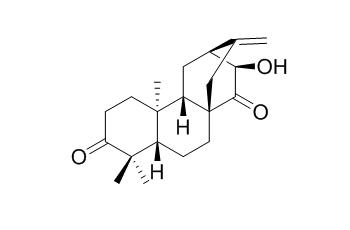Antiquorin
Antiquorin exhibits moderate cytotoxic activities against the human lung cancer 95-D cell line with the IC50 value of 34.5 uM.
Inquire / Order:
manager@chemfaces.com
Technical Inquiries:
service@chemfaces.com
Tel:
+86-27-84237783
Fax:
+86-27-84254680
Address:
1 Building, No. 83, CheCheng Rd., Wuhan Economic and Technological Development Zone, Wuhan, Hubei 430056, PRC
Providing storage is as stated on the product vial and the vial is kept tightly sealed, the product can be stored for up to
24 months(2-8C).
Wherever possible, you should prepare and use solutions on the same day. However, if you need to make up stock solutions in advance, we recommend that you store the solution as aliquots in tightly sealed vials at -20C. Generally, these will be useable for up to two weeks. Before use, and prior to opening the vial we recommend that you allow your product to equilibrate to room temperature for at least 1 hour.
Need more advice on solubility, usage and handling? Please email to: service@chemfaces.com
The packaging of the product may have turned upside down during transportation, resulting in the natural compounds adhering to the neck or cap of the vial. take the vial out of its packaging and gently shake to let the compounds fall to the bottom of the vial. for liquid products, centrifuge at 200-500 RPM to gather the liquid at the bottom of the vial. try to avoid loss or contamination during handling.
BMC Complement Altern Med.2019, 19(1):11
Heliyon2022, 8(2):e08866.
Oncotarget.2016, 8(51):88386-88400
ACS Omega.2023, 8(36):32424-32431.
Tropical Journal of Pharmaceutical Research 2021, 20(6):1165-1170.
Integrative Medicine Research2024, 13(1):101025.
Food Bioscience2023, 59:103903
J Agric Food Chem.2020, 68(51):15164-15175
Planta Med.2016, 82(13):1208-16
Polytechnic University of Catalonia2017, 105826
Related and Featured Products
Helvetica Chimica Acta, 2013, 96(6):1182-1187.
Unusual Guaiane Sesquiterpenoids from Artemisia rupestris.[Reference:
WebLink]
METHODS AND RESULTS:
Two new guaiane sesquiterpenoids, (1β,5β)-1-hydroxyguaia-4(15),11(13)-dieno-12,5-lactone (1) and 1,5-epoxy-4-hydroxyguai-11(13)-en-12-oic acid (2), together with five known compounds, rupestonic acid (3), strobilactone A (4), Antiquorin (5), isosclerone (6), and 5-hydroxy-2′,3′,4′,7,8-pentamethoxyflavone (7), were isolated from a 95% EtOH extract of Artemisia rupestris. Compounds 1 and 2 are rare examples of guaiane sesquiterpenoids, incorporating a 12,5-lactone group or featuring a 1,5-epoxy ring, respectively. The structures of 1 and 2 were identified by various spectroscopic methods.
CONCLUSIONS:
Compounds 1, 4, and 5 exhibited moderate cytotoxic activities against the human lung cancer 95-D cell line with IC50 values of 11.3, 19.8, and 34.5 μM, respectively.
Chinese Journal of Natural Medicines, 2010, 8(2):101-103.
Diterpenes and triterpenes from the roots of Euphorbia fischeriana.[Reference:
WebLink]
To study the terpenes in the roots of Euphorbia fischeriana.
METHODS AND RESULTS:
The compounds were isolated by silica gel column chromatography,and their structures were identified on the basis of physiochemical and spectral data.Eight diterpenes and four triterpenes were obtained from the ethyl acetate extract,and their structures were elucidated as jolkinolide A(1),jolkinolide B(2),prostratin(3),ent-kaurane-3-oxo-16α,17-diol(4),Antiquorin(5),neriifolene(6),ent-atisane-3β,16α,17-triol(7),kauranoic acid(8),aleuritolic acid(9),24-methyl-enecy- cloartanol(10)and lupenyl acetate(11).
CONCLUSIONS:
Compounds 4-10 were isolated from this plant for the first time.



